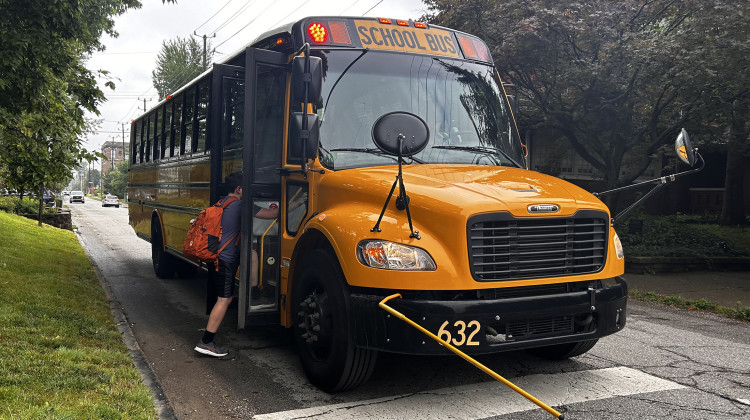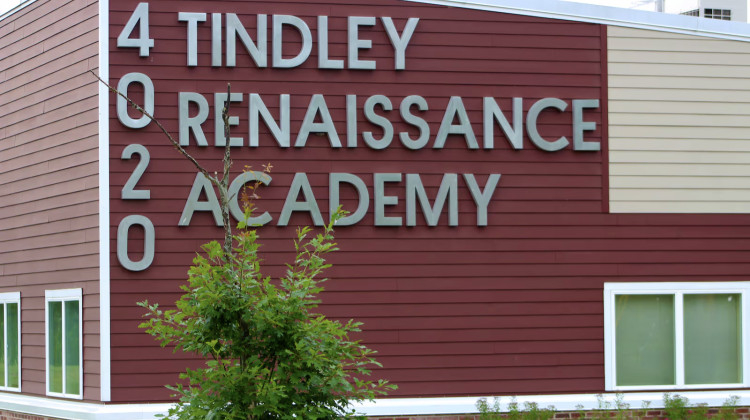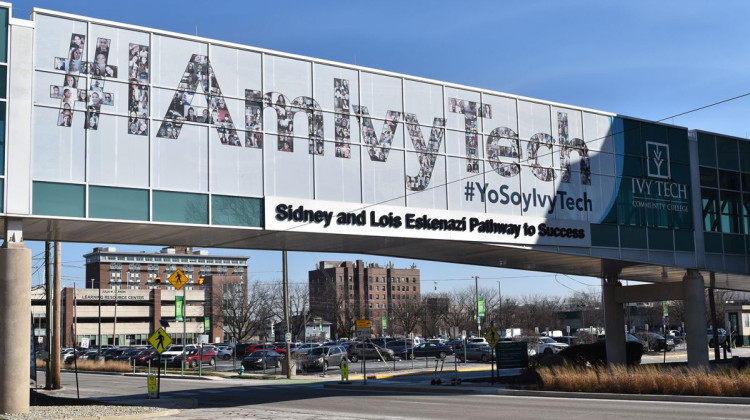LaToya Tahirou stands behind her daughter Lamya Hale at their Carriage House East apartment. Lamya will enter the sixth grade at PLA @ 103 in August. She likes the school because “teachers are close to you, and they love you.” (Photo by Eric Weddle, WFYI)
When Lamya Hale started at School 103 last August as a fifth grader, the experience began like others she had dealt with at city schools.
Hale was bullied by other students. At 103, she says, it caused her to break down crying a few times a week during class. But then something different happened when a teacher stepped in.
“She taught me to just stay strong and not worry about anything else,” the 11-year old said recently. “That is what I like about that school. The teachers are close to you, and they love you.”
That interaction made Lamya’s mom, LaToya Tahirou, very happy. Even though School 103 was just a few blocks from their Carriage House East apartment on the Far Eastside, Tahirou hadn’t considered it until last year.
Unaware of the school’s past history, Tahirou was surprised by its strong pull to engage parents — not just get them in the door but make them feel like they had something at stake in the school’s success.
Tahirou says a high quality school is a vital piece to changing her neighborhood — one of the city’s most dangerous.
Right now, she says, people feel like they have one option to improve their lives — moving to a township or northward to the suburbs.
But she doesn’t accept those options.
“We should be working on bettering our own neighborhood where we are from. And if you chose to move or relocate, that is fine, but you shouldn’t be moving from here to better yourself,” Tahirou said. “We should have quality right here — housing and schools and everything else.”
A Simple Formula
For years, the neighborhood elementary school, K-6 Francis Scott Key School 103, desperately struggled.
Up until last year, School 103 was the worst performing school in the Indianapolis Public Schools district. In 2013-14, 85 percent of the students did not pass both the English and math portions of the ISTEP. The next year, 90 percent of students failed both.
The school has been rated a “F” by the state for five consecutive years.
It was also one of the most violent public schools in the city with 119 fights reported during 2014-15. That pushed the elementary into the ranks of the city’s high schools for most physical altercations.
And that’s all part of why IPS decided to restart School 103 and let Phalen Leadership Academy president Earl Phalen remake the school as PLA @ 103 — a pre-K through six school.
Phalen was given autonomy to run PLA @ 103 just like the charter school he opened in 2013 on North Illinois Street.
“The work is incredibly hard, but the formula is not complex,” he said.
That formula, Phalen explained, includes leadership, partnering with parents and holding children to high expectations.
“And great teachers — you just try to clear everything out of the way for great teachers so they can focus on teaching the rigorous curriculum and program,” he said.

Principal Agnes Aleobua talks about School 103’s first year under Phalen Leadership Academy during a State Board of Education hearing on June 2, 2016 at the school. Although unlikely, the State Board could vote to takeover the school if it receives a sixth consecutive “F” on the state grading scale. (Photo by Eric Weddle, WFYI)
When the 2015-16 school year began at least 80 percent of students were a year behind in math and English, and 63 percent of students were ranked in the bottom 25 percent nationally in reading.
But academic problems aside, a major goal for the year was just getting students to be kind to each other and school staff.
“That is a constant grind to keep reminding children of how we are going to behave and how we are going to carry ourselves,” Phalen said.
And that’s because these are kids with a lot of distractions.
Students at 103 are the most transient of all city schools — meaning it’s likely that a class of kindergarten students will be completely different students by the time that cohort reaches third grade.
Unstable families, loss of jobs and all sorts of other sudden economic impacts cause students’ families to move out of the neighborhood and switch schools, Phalen said. All of that instability prevents teachers from building relationships with students or forging a school culture.
“We have kids who need a lot of extra support because they are still struggling in this environment,” Phalen said, of behavior problems that persisted months after school started.
During visits to the school the past year, students were seen engaged, following teachers with their eyes and responding with the “10 Finger Woo” shout-out to support classmates.
Phalen says those type of classrooms will eventually lead students to change their behaviors and be open to asking for help.
“If you keep that up over time, this becomes a safe place,” he said.
Agnes Aleobua is principal at the school — though Phalen is a regular presence. The first choice of principal, who was awarded a Mind Trust fellowship along with Phalen to design the school, was removed before classes began.

Principal Agnes Aleobua talks about School 103’s first year under Phalen Leadership Academy during a State Board of Education hearing on June 2, 2016 at the school. Although unlikely, the State Board could vote to takeover the school if it receives a sixth consecutive “F” on the state grading scale. (Photo by Eric Weddle, WFYI)
Two Teachers In Every Room
Restarting the school as PLA @ 103 hasn’t been cheap.
Phalen has brought in nearly $2 million dollars in federal and philanthropic aid to pay for training, staff and building upgrades, such as installing carpet in classrooms.
In addition to the state’s per pupil student tuition, IPS has provided start-up costs, including around $428,000 for “preoperational” expenses, and software licenses and hardware. IPS also pays a monthly management fee to the Phalen company. A full accounting of funds PLA @ 103 received for its first year from the district was not immediately available.
Since the school operates autonomously of IPS, and teachers are not bound by the district’s collective bargaining agreement, Phalen has a greater say-so on how funds are spent.
That’s allowed him to ensure there is two adults in every room — a licensed teacher and an aide. No other IPS school offers that outside of the district’s Montessori programs.

A teacher plays guitar and sings a version of “Be My Baby” by The Ronettes as students work on art projects and sing along with the chorus. (Photo by Eric Weddle, WFYI)
In the classroom, students are taught using a “blended learning” model that includes working in small groups with other students and using a personalized computer program that tracks their progress weekly.
But success is also measured in small gestures, like in teacher Ashley Floreancig’s third grade classroom when she saw students sharing an eraser during the second month of classes.
“It sounds really minor, but that can be a big deal,” Floreancig said.
Questions Of Intent
Not everyone has supported the district’s shift to work with private companies or groups — a method known as the “portfolio model” — to manage troubled IPS schools.
A partnership between IPS, education reform group The Mind Trust and the Indianapolis Mayor’s Office paved the way for the growing number of these partnerships, of which PLA @ 103 is the first.
IPS School Board member Gayle Cosby was the lone vote in 2015 against Phalen restarting School 103. One concern, she said then, was a lack of multi-year performance data at Phalen’s first school, which has yet to receive a letter grade from the state because it hasn’t been around long enough. (For the past two years, all third-grade students at the school passed the state’s reading proficiency exam.)
“I just feel like this is a gamble that we really shouldn’t take at this time,” Cosby said during the March meeting. “I can’t gamble with our kids’ education.”
Criticism didn’t stop there.
Last fall during an NAACP forum about IPS, Superintendent Lewis Ferebee faced sharp questions on the Phalen partnership.
State Rep. John Bartlett, an Indianapolis Democrat, said the 2014 law that allows IPS to work with private companies, like Phalen, is chipping away at the district.
“I didn’t agree with it then, and I don’t agree with it now,” he said about discussions he and Ferebee had in the Statehouse. “It is to dismantle the public school system, and we are using IPS for the model — in my opinion.”
During that forum, Ferebee grew impatient with the repeated demands for accountability and concerns that the portfolio model is not in the best interest of children.
“It is my responsibility, and I take wholeheartedly every day, to create those opportunities to make sure every child —regardless of their zip code, regardless of their socioeconomic status — has access to a high-quality school,” Ferebee said, as his voice began to rise. “And I don’t think anybody in this room can argue against that and don’t see the importance of ensuring students have those opportunities.”

Earl Phalen, CEO and founder of Phalen Leadership Academies charter school company and Summer Advantage, stands in a classroom of 103, the second Phalen school in Indianapolis. Phalen said critics of his partnership with IPS to manage the school just “want to play politics with kids.” (Photo by Eric Weddle, WFYI)
The critiques don’t sit well with Phalen either.
“It is such bull,” he said a few months later during an interview at the school. “There was not one community group that was complaining about the quality of 103 (in 2014-15) and the lack of education that took place and the chaotic environment it was in.”
A Decades-Long Investment
There’s a lot riding on School 103. Not just as the example for IPS’s new way of improving schools but making it an integral piece for what could become Indianapolis’ most ambitious social initiative.
Marianne Glick’s family ties run deep in the Far East Side. Her father, Gene B. Glick, built homes and apartments in the area starting in the 1950s. His name is on the front of Carriage House East apartments — where 11-year-old Lamya and about 900 other people live and the Glick’s still operate.
“We have a long history with that neighborhood and don’t see a lot of others going ‘Gee, let’s run out to 42nd and Post and do work,’” the philanthropist said.
So Glick is overseeing the start of the Far Eastside Success Initiative — a literal cradle-to-career, decades-long investment that would provide everything from free preschool and college scholarships, to support for seniors and stable housing options on the Far Eastside.
Glick Philanthropies, Central Indiana Community Foundation, United Way of Central Indiana and IPS are funding and/or managing parts of the initiative.

The Carriage House Apartment sign bears the Gene B. Glick name. The complex is part of the Far Eastside Success Initiative, and one-quarter of School 103 students live there. (Photo by Eric Weddle, WFYI)
Carriage House East is the anchor of the plan and School 103 is a major focus for support. About a quarter of the students at the school live in the apartment.
Last year, the Glick foundation gave the school nearly $500,000 to support the cost of two full-time staff members focused on connecting with parents, refurbish the school and train staff. There’s also been additional support from the foundation and United Way to launch the school’s preschool program.
The geographic area of the initiative is bound by East 42nd Street on the north and East 38th Street on the south, and Post Road on the west and just east beyond North Mitthoeffer Road.
In that area, there are around 4,500 people, including 750 children age five or under and 40 percent under age 18, according to research from the United Way.
Nearly a third of them have annual household incomes of less than $10,000.
“This is not going to turn around overnight,” Glick said. “Not until we see these children that are born today, that they have graduated college or that they ave a self-sustaining job — we will have not done our job. And hopefully they will want to go back into the neighborhood and continue the growth that has begun now.”
If this all sounds like a massive aspirational goal — that’s because it is.
And while the full extent of the program has yet to be rolled out, much is underway in addition to the support for School 103:
-
The Glick Family Housing Foundation, a 501(c)3 charitable not-for-profit organization, purchased Carriage House East apartments earlier this year. That will let charitable donations help families remain in the apartment complex if they hit rough times.
-
John Marshall High School graduates who live in the Far Eastside can now allow apply for scholarships from the United Negro College Fund — scholarships seeded by a $20,000 Glick Fund donation.
-
A food pantry was opened Carriage House East by Community Alliance of the Far Eastside and others.
- The initiative is planning next to expand on health, workforce development, adult education and public safety programs.
The Far Eastside Success Initiative is based, in part, on a similar program in Tangelo Park near Orlando, Florida, where there’s been a reduction in crime, stabilized schools and increase in college graduates. What it took was a businessman’s $11 million philanthropic investment over the past 20 years into one neighborhood.
Glick says the family fund is prepared for a minimum of a 20-year investment on the Far Eastside.
Little Steps
IPS Superintendent Ferebee believes the initiative can have a similar impact as seen in Florida.
“If we truly are going to address education and crime and health in the community, what are all the supports that are needed to change outcomes?,” he said. “So we tried to build it based on what we learned from others. We also saw it as meeting the specific needs of the families in our community.”
At home in her Carriage House East apartment, LaToya Tahirou says she hasn’t heard much about the initiative, but by the little she knows — it feels like exactly what is needed.
But for now, she just wants School 103 to keep getting better for her daughter and the other children in the neighborhood.
She is happy with the improvements so far: enrollment increased by more than 20 percent from 325 students in 2014-15 to 400 students now; preliminary reading scores improved by 10 percentage points; and the number of fights were cut by 69 percent. Scores for the most recent ISTEP exam have not been released by the state.
Next year, 7th grade will also be added to School 103 to allow students, like Lamya, to remain there an additional year before choosing a middle or high school.
“It’s going to take a while. They didn’t get in that position overnight,” Tahirou says about the school. “They are not going to come out of it overnight. So as long as little steps are being made to go forward, that is all that matters.”
 DONATE
DONATE






 Support WFYI. We can't do it without you.
Support WFYI. We can't do it without you.